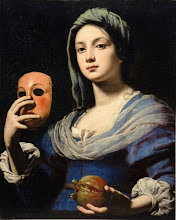
Las Meninas (the Maids of Honour), Velasquez, Prado Museum.
Some argue that, because it seems to depict perception itself, Las Meninas is the greatest painting in Western Art.
"All experience is had from a point of view, which is not represented in the experience itself, but is, as it were, its inner limit. Its outer limit is equally elusive, like the boundary of the visual field. beyond which there is nothing else on the same level." Wittgenstein takes up this Schopenhaueresque idea.
Wittgenstein argues "in the Tractatus that, when the solipsist claims that all experiences are had by his ego, he fails to connect his ego with his body and so there is no justification for calling it 'his'. It lacks a criterion of identity and it may just as well be the collective ego of the whole human species - an interpretation which points to idealism rather than solipsism. There is a dilemma here. For if the solipsist does tie his ego to his body, his claim will be self-refuting, because his body is placed in the world among other bodies, each with its own field of consciousness. This shows that the solipsist's field of consciousness cannot be a breakaway world.
The solution to the problem of the ego is implicit in the Tractatus but it is worked out in detail in Wittgenstein's early middle period. The ego itself vanishes without our feeling any sense of loss. My field of consciousness, like the field of vision that it contains, is self-authenticating: if a sensation occurs in it, I do not even have to ask myself whose it is. There is no inner owner for me to point at and I may as well drop the word 'I' and say, 'there is pain'."
- David Pears, Wittgenstein.



















No comments:
Post a Comment